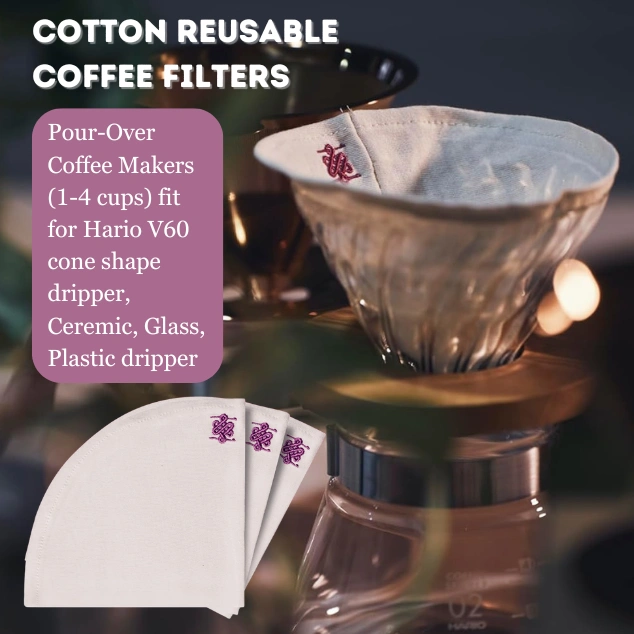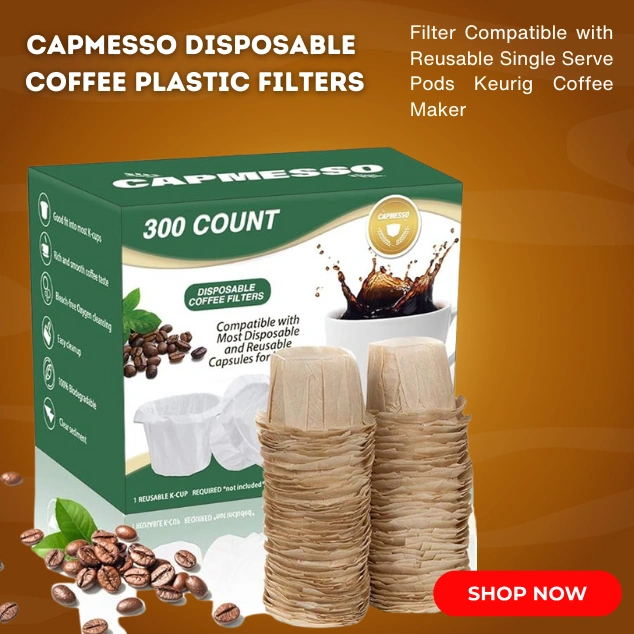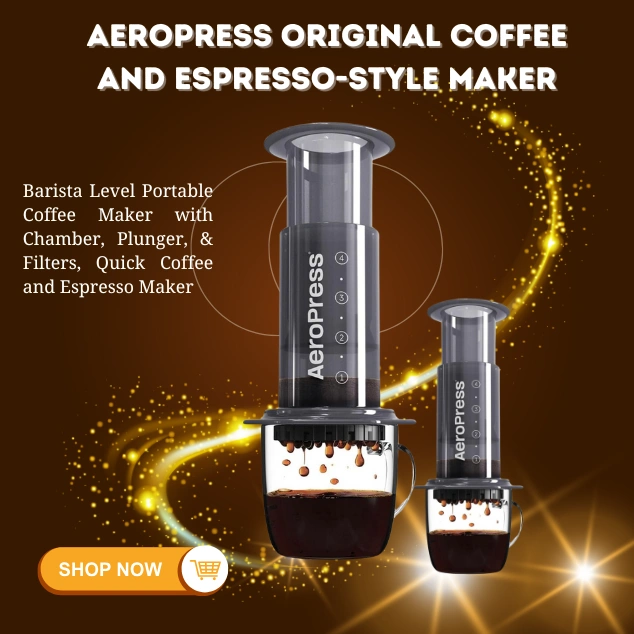”How to Choose the Best Coffee Filter: Your Ultimate Guide”
The filter employed can notably affect the making of an ideal cup of coffee. Of course, most people don’t think twice before choosing a coffee filter. Still, knowing that they impact everything from flavor to mouth feel is important in the brewing process.
It will prove difficult to select one from such a variety. This article will take you through all there is to know about what makes the best type of best coffee filter including how it is made and brewing techniques
Table of Contents
Why Best Coffee Filters Matter?
But as we look at different types of filters, let us first examine the importance of filters. Best Coffee filters separate ground coffee from brewed liquid thereby ensuring a smooth and sediment-free cup.
The type of filter used influences the taste. It determines how much of the coffee’s oils and flavors are allowed into the final cup. It also affects the amount of fines (the tiny particles) going into the cup.
Some filters let through more oils. This results in a cup that is richer and has a fuller body. Other filters prevent oils as well as fine particles from passing. Hence, it gives the coffee a cleaner or crisper taste.
Depending on what you like best when it comes to coffee flavor and how you want to brew your coffee, the appropriate filter for you is available

Types of Best Coffee Filters: A Breakdown
To make wise decisions, we will examine different best coffee filter types, their advantages and disadvantages
1. Paper Filters
Among different types of best coffee filters, paper filters are probably the most popular. They are generally for one-time-use hence easy to throw away. Moreover, they come in various shapes and sizes. These can fit into many brewing techniques like drip machines, pour-overs, or some models of aero presses.
Pros:
- Simple to employ and discard
- Steady and trustworthy filtration
- Generates a pure cup with few oils and sediment
- Some of the essential oils from the coffee are eliminated during the process, causing it to lose its original taste.
- It is not eco-friendly as it leads to waste considers best coffee filter.
Cons:
- Some of the essential oils from the coffee are eliminated during the process, causing it to lose its original taste.
- It is not eco-friendly as it leads to waste.
Choosing Between Bleached vs. Unbleached Paper Filters:
Usually, we have two types of best coffee filter one is paper filters: bleached and unbleached. Bleached filters have undergone treatment to make them white. Unbleached filters are brownish in color or nearer to their natural appearance.
| Bleached Filters | Unbleached Filters |
| As they do not affect the taste of coffee, these filters are usually chosen for their appearance. The concern rests with the substances included in the process of bleaching. In recent days, the majority of bleached filters use oxygen rather than chlorine for purification, hence being more secure. | These filters are less processed. They may give your brew a slight paper taste. This is especially true if you do not rinse them before use. A more environment-friendly choice they are because there is no chemical bleaching involved. |
2. Metal Filters
These best coffee filters made of metal, typically stainless steel, can be used more than once. They have little to no negative impacts on the environment. They are commonly utilized with pour-over techniques like CHEMEX or Hario V60. They are also used in certain French press and AeroPress devices.
Pros:
- Can be used over and over again while being resistant to wear and tear, hence minimizing the amount of rubbish produced
- Permits greater quantities of oil and tiny insoluble particles to go through it thus giving it a more intense rounder taste
- Cheaper in terms of expenses in the long haul.
Cons:
- After each utilization, it necessitates cleaning.
- So, minor deposits go through it hence making the beverage look somewhat turbid.
- This option is unsuitable for someone who enjoys better clarity and freshness in taste.
- Metal filters can enhance the natural flavors of the coffee and create a more robust, complex cup. Still, they need a little more maintenance and care than disposable options.
3. Cloth Filters
Cloth best coffee filters are not common among coffee fans searching for an environment-friendly and reusable choice to paper. Yet, they are becoming more popular. Usually, they are composed of organic cotton. So, these filters are used in pour-over and siphon brewing techniques.
Pros:
- Usable again and again as well as friendly to the environment
- It makes some oils pass through it for a balanced flavor while ensuring a clean cup
- Has a softer feel than paper or metal filters.
Cons:
- Bacterial accumulation can be prevented through regular cleaning and maintenance
- Compared to metal filters, it’s required often to change
- It can change the taste of your coffee if not cleaned properly.
- Cloth filters are somewhere in the middle of paper and metal filters. They let through some oil that makes coffee rich, but also they produce coffee that is clean enough.
4. Perforated Plastic Filters
Among the various types of coffee machines, some use perforated plastic best coffee filters. These filters can be reused and cleaned with relative ease. Most of them possess a net-type setup like a metallic filter does.
Pros:
- Reusable and easy to wash
- Durable and can last for long
- Gives room for better-bodied coffee as it allows through more oils
Cons:
- May absorb different smells or tastes over time
- Less commonly used compared to other types of filters
- If not managed properly, can lead to plastic pollution
How to Match the Right and Best Coffee Filter to Your Brewing Method for Perfect Results
1. Drip Coffee Maker
The most popular brewing method is the drip coffee maker, and it is best used with paper filters. Most machines are built to work with either cone-shaped or basket-style paper filters. If you want to be more environmentally conscious, some drip coffee makers come with aluminum or plastic filters. They can also use reusable ones.
2. Pour-Over
The pour-over techniques recommended include Chemex, Hario V60, and Kalita Wave which have gained immense acceptance among the coffee zealots. Using a paper filter is better when a cleaner and crispier coffee is desired. This is particularly true in the Chemex where thick papers are employed for filtering. Alternatively, metal filters can be employed if a more flavorful and heavier oil is preferred.
3. French Press
Traditional best coffee filters are not involved in the French press method. Yet, this method relies on a metal mesh plunger. It performs comparable functions. So when using this tool, you should forget about using paper filters. You only have to make sure that your plunger is properly cleaned. Make sure its mesh is fine enough to let oils go but trap some of the coffee grinds.
4. AeroPress
The AeroPress is an adaptable brewing instrument compatible with either paper or metal filters. When you use paper filters, you will have cleaner and crisper cups of coffee. Metal filters produce a thicker body and oilier drink.
5. Espresso Machines
The built-in in-port best coffee filter of espresso machines are metal filters. They allow most of the coffee’s oils and flavors through. Thus, using paper filters in espresso machines is unnecessary.
Factors to Consider When Choosing The Best Coffee Filter
At this point, we’ve seen all types of best coffee filter and how they relate to brewing techniques. Let’s get down to some other things that one must consider when selecting the best coffee filter for your coffee.
1. Taste Preference
Is it a smooth and pristine mug that some people like? Or is it an oily drink that has more body? The paper filters give a cleaner flavor. The metallic or cloth ones allow more oils and fines. This results in a bold taste. Ultimately, it is left to individual preferences in taste.
2. Environmental Impact
Reusable filters like those made of cloth or metal are recommended for environmentally conscious people. Paper filters are not very green because they are single-use, especially the bleached ones. For people who love coffee brewed with paper filters, go for unbleached and compostable ones.
3. Convenience
The most convenient choice is disposable paper filters. They need no upkeep and can be discarded after each use. Alternatively, metals and clothes that can be reused need much more effort. They must be washed completely each time they are used.
Consider how much time you are willing to spend preparing coffee. Think about the energy you are ready to invest in your routine.
4. Cost
In the beginning, paper filters come cheap. They are not economical in the long run, especially if one brews coffee every day. Metal and cloth filters seem costly at first. But, using them for years saves you money. Think about how much money you have before making a choice.
5. Compatibility
Make sure compatibility between the filter of your choice and the brewing method that you use for making your coffee. Some coffee makers are built explicitly for particular types of filters. If you use an incompatible one, the result is a poor brew. It can even cause spoilage of the machine itself.

How to Care for Reusable Coffee Filters
Just like this, opaque coffee filters act as a tool used by someone who produces coffee from dry coffee plants. They usually have a fine sieve-like structure through which only transparent substances pass.
The coffee filter’s working principle is simple. It separates the water from the solid content of ground or roasted coffee beans.
Whenever you choose the choice of reusable coffee filters, good care ensures proper functioning and a longer lifespan. Thus, the next are some of the tips for putting your filters in perfect condition:
Metal Filters:
- Rinse with water after every usage for coffee grounds to go off
- Drain with a blend of vinegar and water to remove built-up oils and lard once per month.
- Scrub using a soft brush to clean the mesh gently and make it transparent.
Cloth Filters:
- After using rinse it straight away and air dry.
- In a week boil the filter in water to remove oil and germs.
- Every couple of months replace to keep the best performance.
Conclusion
Selecting the best coffee filter depends upon what you like, care for, and how you brew your coffee. Choosing the right filter can enhance your enjoyment of coffee. It depends on whether you prefer paper for convenience, metal or cloth for eco-friendliness, or plastic for versatility.
You should never shy away from trying various kinds until you discover one that makes your ideal cup.
Understanding how different filters affect taste and feel can be beneficial. This knowledge helps individuals choose a cup that suits them best. It prevents them from just drinking any other cup at the local café. Enjoy brewing!
“Want to dive deeper into coffee brewing? Explore more tips and guides in our other articles!”
- The Best Coffee Accessories for a Barista-Quality Experience at Home
- What to Know About Coffee Pod Vending Machines for Modern Convenience? A Perfect Guide
- “Top Commercial Drip Coffee Machines: A Guide to Choosing the Best Brewer for Your Business”

Top 5 FAQs on Choosing the Best Coffee Filter
-
What are the different types of best coffee filters?
Paper, metallic, and fabric are the three key categories of coffee filters. Paper filters tend to be the most widely used, metallic filter designs have the advantage of being reusable while cloth filters give distinct flavor notes. Consequently, every option affects the taste and the way a cup is brewed.
-
Which coffee filter makes the best-tasting coffee?
Despite everything, it is subjective! Clean and smoother flavors are the characteristics of drinks made using paper filters while metal options provide richer tastes since they let more oils pass through. In comparison with other types of materials used in filtered beverages, cloth filtering offers something right in between but requires are demanding form of upkeep.
-
Is it better to use bleached or unbleached paper filters?
Because they are not subjected to chemicals, unbleached filters are friendlier to the environment. The whiteness of bleached filters does not impact flavor but in case you care about Mother Nature so much then choose unbleached ones.
-
Are metal filters worth it?
In case you want an option that will last, is friendly to the environment, and is cost-effective, then you should go for long-term metal filters. These metal filters however allow more coffee oils and finer grounds hence it becomes very body-rich. Some people still perceive its taste as too intense, though.
-
Do best coffee filter shapes matter?
The coffee filter’s form can change how the water brews. Generally, flat bottom filters are more consistent than cone filters that channelize the water flow probably resulting in greater strength. Your coffee’s strength and quality may also be influenced by your filter design.
These questions can provide guidance for individuals searching for a coffee filter that suits them best!















I really like your writing style, excellent information, regards for putting up : D.
Thanks for any other magnificent post. Where else may just
anybody get that type of information in such a perfect manner
of writing? I have a presentation subsequent week, and I’m on the look for such information.
he should be even more concerned about his health.he is no longer exercising and he is eating junk food that he would never even consider eating when he was younger.高級 オナホ
While the solicitor was employed in thisnegotiation,ラブドール 販売he despatched his valet-de-chambre to one nobleman,